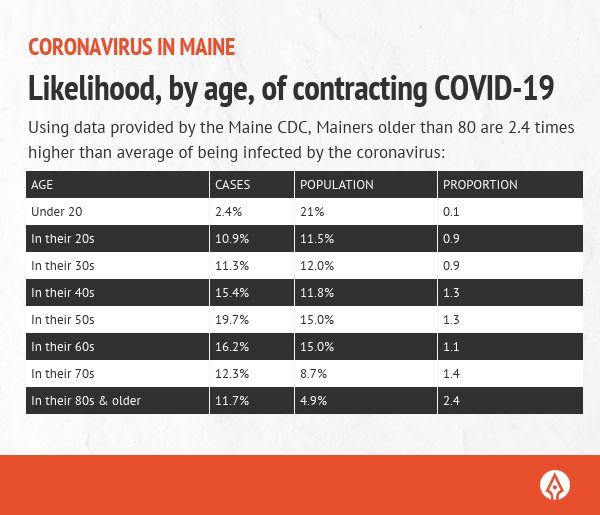The main argument of a legal case against Gov. Janet Mills’ directives to protect Maine people is that the COVID-19 situation is not bad enough to warrant her actions. The economy should be opened.
The complaint misses four key points:
- Older Mainers are especially hard hit by COVID-19.
- Cumberland County, an economic center, has double the average virus impact.
- Maine’s curve is not flattening.
- Some people may remain cautious, not boosting the economy, even if rules are relaxed.
According to the complaint, only a small percentage of the population is dying, so the state should be open. This theory is based on ignorance of the impact of COVID-19 in Maine, partly due to insufficient data and testing, plus back-of-the-envelope calculations.
The complaint amounts to saying that if crime is low, police are not needed. No thought need be given to the role of the police in keeping crime down, just as protective measures get little credit for limiting COVID-19 cases.
An unknown factor is the percentage of the population that has the illness without being aware of it. To be sure, they may be able to go about their business, but they are also able to spread COVID-19 to others.
The Maine CDC provides a daily scorecard on the illness, but its reports lack vital context. For example, as of last weekend Maine CDC reported that 11.7 percent of the known cases involved people in their 80s. These people are only 4.9 percent of the state’s population.
In short, Mainers in their 80s are 2.4 times above average in their likelihood of getting COVID-19. Here is the table for each age group used by the Maine CDC.

The table shows that people in their 20s, 30s and 60s are about as likely to contract COVID-19 as the average person. People under 20 are far less likely, and people 70 and older are more likely. The data confirms that the older you are, the more vulnerable you are.
While those complaining about Mills’ policies want the court to believe that only a tiny number of people would be affected, a calculation using the state’s total population (population x share of 80s in population x share of 80s with COVID-19), shows that 7,641 Maine people in their 80s can be expected to contract the illness.
Older people succumb to the illness at a higher rate than others. According to the U.S. CDC, 59 percent of deaths from COVID-19 occur among people 75 and older.
In short, the case against Maine’s efforts at protection, alleging a low incidence of death, targets seniors. The opponents implicitly accept that economic recovery is worth human lives, especially several hundred older Mainers. (Disclosure: I am an older Mainer.)
In an attempt to minimize the COVID-19 impact, critics suggest that the total state death rate has not increased much. In other words, if there’s little increase in the number of people dying, why worry about the virus?
This argument is false science. Its proponents have no idea what drives the general death rate and how it has varied, under a wide range of influences, over the years. It’s like saying a little snow a few days ago proves that the climate has not been growing warmer over decades.
Maine CDC reports the number of new cases each day and the cumulative number. To see the trend line of new cases over time, the best source is the New York Times. It shows the famous curve that needs to flattened so that our healthcare system is not over-stressed. Because Maine’s curve is rising, it is not as encouraging as the lawsuit would make it seem.
While Maine CDC reports cases by county, like the age question it doesn’t determine how hard-hit counties may be. By last week, Cumberland County had 48.7 percent of the known cases but only 21.8 percent of the population. People there were 2.2 times more likely to contract the illness than the state average.
Daily reports may have led people to shrug off the Cumberland County numbers as being normal for the state’s most populous county. Obviously it was far from normal. Only two other countries joined Cumberland as being especially vulnerable – York (1.2 times) and Waldo (1.2 times). The discussion of the virus’ impact never mentions this.
Mills relaxed rules in all but four counties, which had community spread. Along with Waldo, Kennebec saw requirements eased, though it had more cases than Androscoggin, still under higher protection. Presumably, the heavy loads in Waldo and Kennebec were due to effects at single sites.
The governor’s order, which splits the state into two zones, contains a border problem. People in one county, living close to a relaxed-rule county, can drive a short distance and shop relatively freely in stores that would be closed in their home county.
The border problem is obscured by the failure of the Maine CDC, unlike other states, to provide COVID-19 impact information by municipality, making it seem it is inappropriately trying to manage the public. This information could both aid local officials in supporting state efforts and warn residents where greatest caution is needed.
Asked about the stay-at-home rule, Mills seemed to say it was still in effect. If a non-essential business could open but people could only leave home for essential purposes, there would be no use in opening non-essential businesses. This conflict also needs to be resolved. Obviously the stay-at-home rule will be honored in the breach.
It’s possible that only truly isolated areas can have different rules. Maybe that’s why Maine can relax its rules faster than other New England states. It is the only state bordering only one other state, and Mills’ 14-day quarantine for new arrivals discourages the flow from elsewhere in the U.S. The border with New Brunswick and Quebec is effectively closed.
Morning Consult, a national polling organization, has added one more piece of data – consumer confidence by state. It plummeted in all states in mid-March when the impact of COVID-19 became well known.
Since then, some states have eased restrictions. Yet in no state, notably those that lifted tough rules or never imposed them, has consumer confidence in the economy recovered appreciably. Maine has gone from a March 1 rating of 111.3 to 74.9 on May 1, third lowest in the country.
The clear message is that governments may relax protection in an effort to restore the economy, but the real decision will be made by the people. They need to feel more comfortable about threats to their health before they will take advantage of all economic opportunity.
To help them make their decisions, people need more information. Maine CDC can do better.







